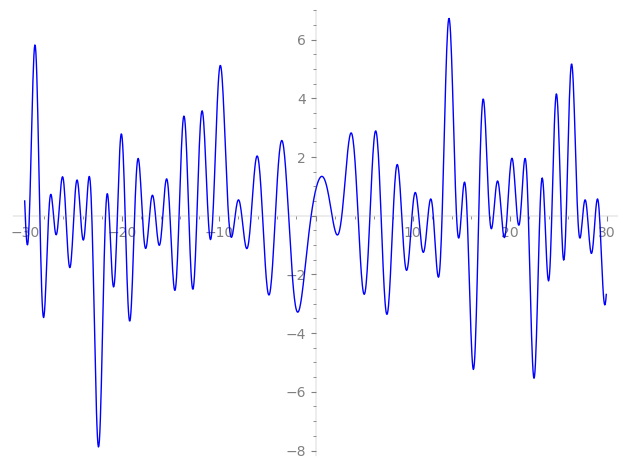| L(s) = 1 | + (−0.836 + 1.44i)2-s + (0.599 + 1.03i)4-s + (−1.93 − 1.11i)5-s + (4.76 − 5.13i)7-s − 8.70·8-s + (3.24 − 1.87i)10-s + (−6.91 − 11.9i)11-s − 6.12i·13-s + (3.45 + 11.1i)14-s + (4.88 − 8.45i)16-s + (2.14 − 1.23i)17-s + (−24.2 − 13.9i)19-s − 2.68i·20-s + 23.1·22-s + (6.62 − 11.4i)23-s + ⋯ |
| L(s) = 1 | + (−0.418 + 0.724i)2-s + (0.149 + 0.259i)4-s + (−0.387 − 0.223i)5-s + (0.680 − 0.733i)7-s − 1.08·8-s + (0.324 − 0.187i)10-s + (−0.628 − 1.08i)11-s − 0.470i·13-s + (0.246 + 0.799i)14-s + (0.305 − 0.528i)16-s + (0.126 − 0.0729i)17-s + (−1.27 − 0.736i)19-s − 0.134i·20-s + 1.05·22-s + (0.287 − 0.498i)23-s + ⋯ |
\[\begin{aligned}\Lambda(s)=\mathstrut & 315 ^{s/2} \, \Gamma_{\C}(s) \, L(s)\cr =\mathstrut & (0.641 + 0.767i)\, \overline{\Lambda}(3-s) \end{aligned}\]
\[\begin{aligned}\Lambda(s)=\mathstrut & 315 ^{s/2} \, \Gamma_{\C}(s+1) \, L(s)\cr =\mathstrut & (0.641 + 0.767i)\, \overline{\Lambda}(1-s) \end{aligned}\]
Particular Values
| \(L(\frac{3}{2})\) |
\(\approx\) |
\(0.802885 - 0.375394i\) |
| \(L(\frac12)\) |
\(\approx\) |
\(0.802885 - 0.375394i\) |
| \(L(2)\) |
|
not available |
| \(L(1)\) |
|
not available |
\(L(s) = \displaystyle \prod_{p} F_p(p^{-s})^{-1} \)
| $p$ | $F_p(T)$ |
|---|
| bad | 3 | \( 1 \) |
| 5 | \( 1 + (1.93 + 1.11i)T \) |
| 7 | \( 1 + (-4.76 + 5.13i)T \) |
| good | 2 | \( 1 + (0.836 - 1.44i)T + (-2 - 3.46i)T^{2} \) |
| 11 | \( 1 + (6.91 + 11.9i)T + (-60.5 + 104. i)T^{2} \) |
| 13 | \( 1 + 6.12iT - 169T^{2} \) |
| 17 | \( 1 + (-2.14 + 1.23i)T + (144.5 - 250. i)T^{2} \) |
| 19 | \( 1 + (24.2 + 13.9i)T + (180.5 + 312. i)T^{2} \) |
| 23 | \( 1 + (-6.62 + 11.4i)T + (-264.5 - 458. i)T^{2} \) |
| 29 | \( 1 - 27.6T + 841T^{2} \) |
| 31 | \( 1 + (16.2 - 9.36i)T + (480.5 - 832. i)T^{2} \) |
| 37 | \( 1 + (-20.5 + 35.5i)T + (-684.5 - 1.18e3i)T^{2} \) |
| 41 | \( 1 + 22.5iT - 1.68e3T^{2} \) |
| 43 | \( 1 - 7.60T + 1.84e3T^{2} \) |
| 47 | \( 1 + (-11.9 - 6.88i)T + (1.10e3 + 1.91e3i)T^{2} \) |
| 53 | \( 1 + (-46.2 - 80.1i)T + (-1.40e3 + 2.43e3i)T^{2} \) |
| 59 | \( 1 + (-61.5 + 35.5i)T + (1.74e3 - 3.01e3i)T^{2} \) |
| 61 | \( 1 + (100. + 57.8i)T + (1.86e3 + 3.22e3i)T^{2} \) |
| 67 | \( 1 + (-5.70 - 9.87i)T + (-2.24e3 + 3.88e3i)T^{2} \) |
| 71 | \( 1 + 99.4T + 5.04e3T^{2} \) |
| 73 | \( 1 + (-90.1 + 52.0i)T + (2.66e3 - 4.61e3i)T^{2} \) |
| 79 | \( 1 + (64.4 - 111. i)T + (-3.12e3 - 5.40e3i)T^{2} \) |
| 83 | \( 1 + 30.3iT - 6.88e3T^{2} \) |
| 89 | \( 1 + (93.9 + 54.2i)T + (3.96e3 + 6.85e3i)T^{2} \) |
| 97 | \( 1 - 153. iT - 9.40e3T^{2} \) |
| show more | |
| show less | |
\(L(s) = \displaystyle\prod_p \ \prod_{j=1}^{2} (1 - \alpha_{j,p}\, p^{-s})^{-1}\)
Imaginary part of the first few zeros on the critical line
−11.09253965754508956956149790256, −10.60272568783886572773699774837, −8.988695164397223216675974589718, −8.307277479602663812557429769351, −7.62327885956019920793963236892, −6.65756997892669558159868068574, −5.48205415807541755634780615244, −4.16352365133923496011455306726, −2.79545150848249359563458089163, −0.47392126369146610629242530154,
1.68831764347460024302857023472, 2.68620103124419782709722424449, 4.36812552469874650973741322402, 5.58767615739395437040679957607, 6.73685017463740464391349524385, 7.973757564843407418276402588895, 8.867228121514827282855495575935, 9.925470901160268529220021048124, 10.61482751865094486890154415386, 11.57211796542838982008918808284

